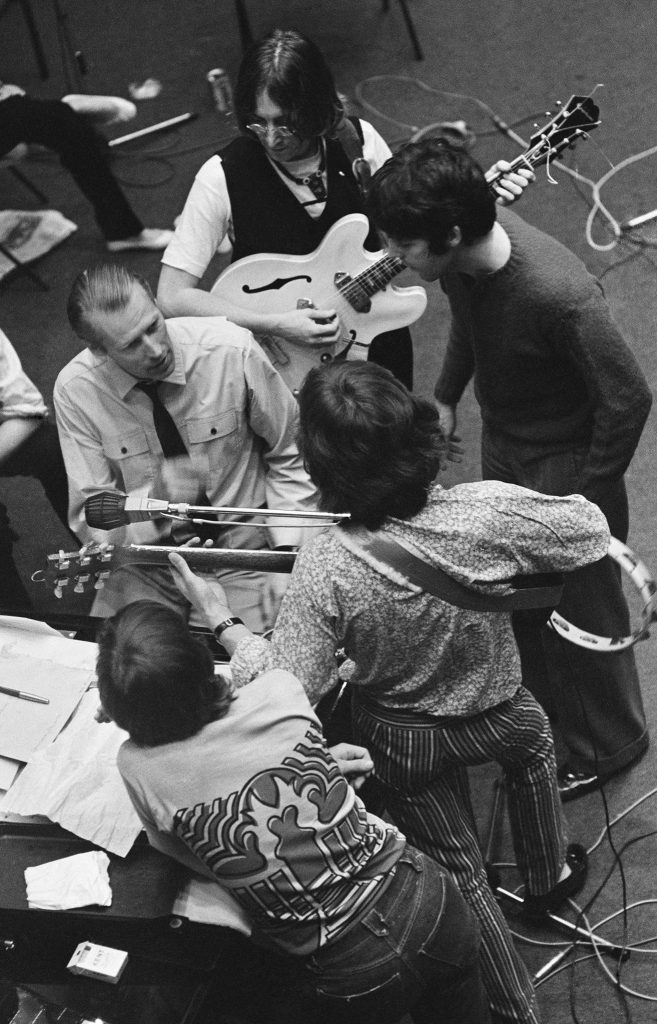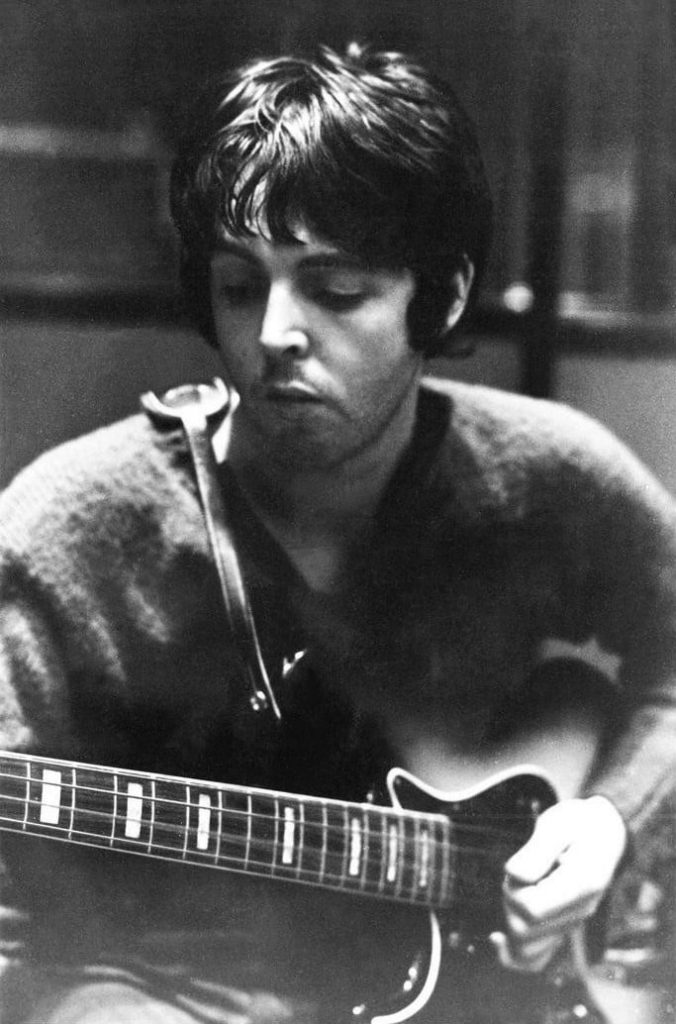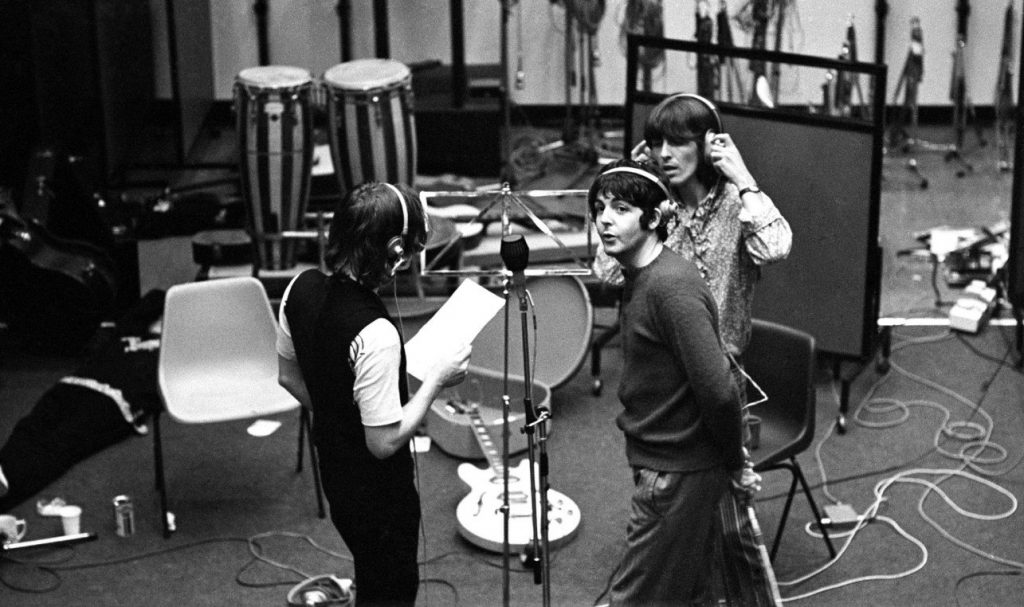"The Beatles" (aka the White Album) sessions
May 30 - Oct 18, 1968 • Songs recorded during this session appear on The Beatles (Mono)
Recording studio: Trident Studios, London, UK
Article Jul 31, 1968 • The Apple shop in Baker Street closes down
Session Jul 31, 1968 • Recording "Hey Jude"
Session Aug 01, 1968 • Recording "Hey Jude"
Article Aug 02, 1968 • "Thingumybob" series premieres on UK TV
Session Aug 02, 1968 • Mixing "Hey Jude"
Some of the songs worked on during this session were first released on the "Hey Jude / Revolution" 7" Single.
After two days of rehearsals and rough takes at Abbey Road, and a day of proper recording at Trident Studios, on this day, The Beatles completed the recording of “Hey Jude“, still at Trident Studios (to benefit from its eight-track recording facilities).
From 5 pm to 8 pm, The Beatles added overdubs onto Take 1, recorded the previous day. Paul McCartney added bass, his lead vocals, while the other Beatles added some backing vocals. Ringo also added a tambourine. John and George also recorded some electric guitar overdubs which went unused.
Then, from 8 pm till 11 am, a 36-piece orchestra was recorded. From The Beatles Monthly Book, September 1968, N°62:
[…] On Thursday, August 1, we imported a 40-piece orchestra, the largest group of accompaniment musicians we’d used since the Beatles did “A Day In The Life” for “Sgt. Pepper” well over a year ago. As you all know by now “Hey Jude” starts out as a plaintive ballad with Paul’s voice well up in front of a fairly simple backing. Then the arrangement begins to build up towards an exciting cimax. That’s where the big orchestra came in. Mostly they just held single notes for long periods to underline and emphasise the whole atmosphere of the recording.
TOWARDS THE END OF THE EVENING WE DECIDED TO MAKE DOUBLE USE OF THE 40 MUSICIANS BY ASKING THEM IF THEY’D LIKE TO DO A BIT OF SINGING AND CLAP THEIR HANDS. THEY WERE QUITE PLEASED TO OBLIGE AND THE ENTIRE ORCHESTRA STOOD UP, CLAPPED AND SANG THEIR “LA-LA-LA” BITS UNDER PAUL’S CLOSE SUPERVISION.
So “Hey Jude” was finished that night at the end of a highly spectacular session. […]
Mal Evans
The orchestra featured 10 violins, 3 violas, 3 cellos, 2 flutes, 2 double basses, 1 contrabassoon, 1 bassoon, 2 clarinets, 1 contrabass clarinet, 4 trumpets, 4 trombones, 2 French horns and 1 percussionist. The musicians’ names are unknown with the exception of Bobby Kok who played cello and Bill Jackman on flute.
We just played the refrain over and over, the repeated riff which plays in the long fade-out.
Bill Jackman
The studio at Trident was long and narrow. When we did the orchestral overdub we had to put the trombones at the very front so that they didn’t poke anyone in the back!
Chris Thomas – George Martin’s assistant
As reported by Mal Evans, most musicians were happy to clap their hands and contribute backing vocals (the double fee surely helped), but one musician refused:
The only time we have had real objections from an orchestra was during the recording of ‘Hey Jude,’ the biggest-selling single of all. I wanted them to sing and clap their hands as well as play, and one man walked out. ‘I’m not going to clap my hands and sing Paul McCartney’s bloody song,’ he said, in spite of the fact that he was getting double rates for his trouble.
George Martin – from his book “All You Need Is Ears”
It was obviously a Paul song, and we actually recorded it with Paul sitting at a piano, singing as he played. Then we overdubbed this fairly large orchestra and we got about forty musicians in the studio, playing their instruments, and, somewhat reluctantly, we also got them singing on the end, because we wanted this general big noise. I don’t think they liked doing it very much. In fact, one of them asked me for a special fee afterwards, which I think he got. ‘Hey Jude’ worked out a very satisfactory record and, in fact, became one of the biggest single sellers that we ever had.
George Marting – From “The Beatles: Off the Record” by Keith Badman
With the recording over, the mixing of the song would start the following day.



The Complete Beatles Recording Sessions • Mark Lewisohn
The definitive guide for every Beatles recording sessions from 1962 to 1970.
We owe a lot to Mark Lewisohn for the creation of those session pages, but you really have to buy this book to get all the details - the number of takes for each song, who contributed what, a description of the context and how each session went, various photographies... And an introductory interview with Paul McCartney!
The Beatles Recording Reference Manual: Volume 4: The Beatles through Yellow Submarine (1968 - early 1969)
The fourth book of this critically acclaimed series, "The Beatles Recording Reference Manual: Volume 4: The Beatles through Yellow Submarine (1968 - early 1969)" captures The Beatles as they take the lessons of Sgt. Pepper forward with an ambitious double-album that is equally innovative and progressive. From the first take to the final remix, discover the making of the greatest recordings of all time. Through extensive, fully-documented research, these books fill an important gap left by all other Beatles books published to date and provide a unique view into the recordings of the world's most successful pop music act.
If we modestly consider the Paul McCartney Project to be the premier online resource for all things Paul McCartney, it is undeniable that The Beatles Bible stands as the definitive online site dedicated to the Beatles. While there is some overlap in content between the two sites, they differ significantly in their approach.

Notice any inaccuracies on this page? Have additional insights or ideas for new content? Or just want to share your thoughts? We value your feedback! Please use the form below to get in touch with us.